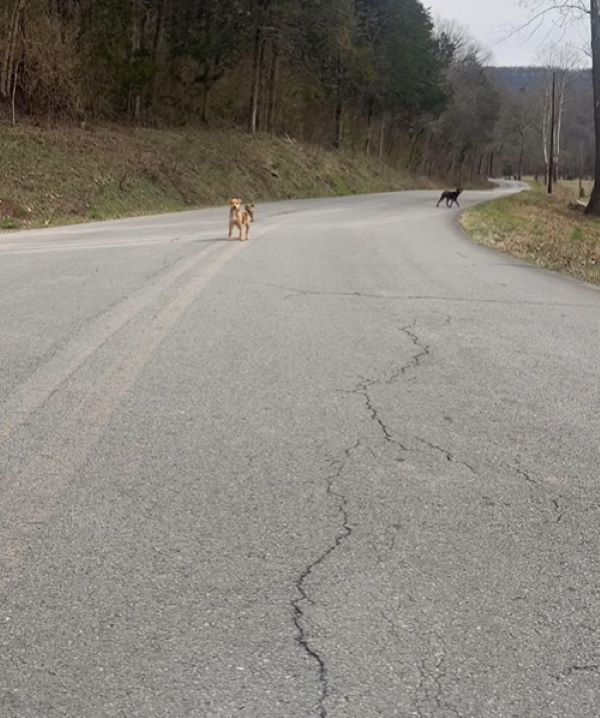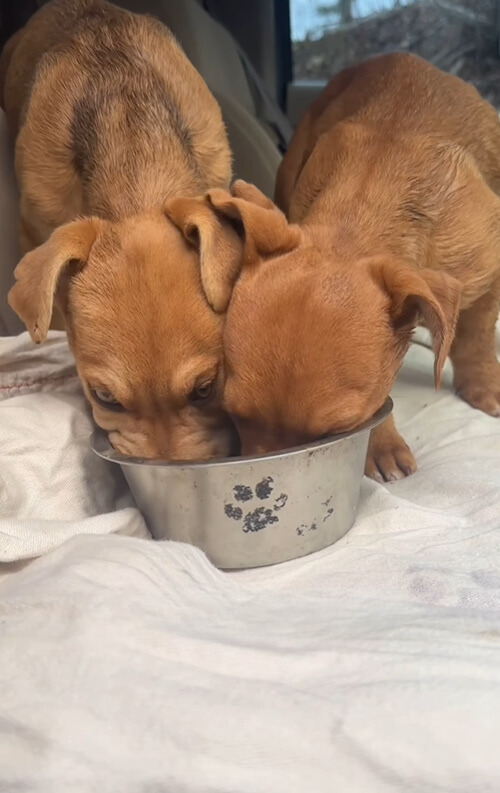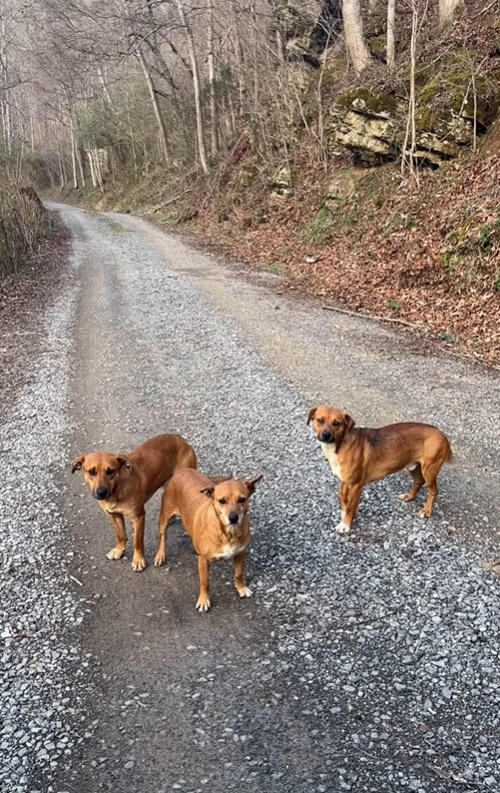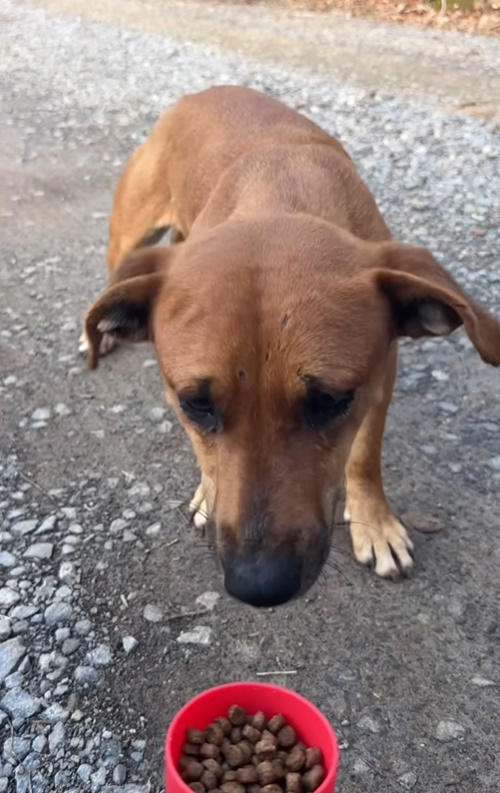Encountering stray dogs on the streets is not a rare thing. In fact, we can all probably name an instance when we run into one during the day.
However, how often have any of us helped or seen somebody helping them in any way? A simple gesture like giving food is sometimes enough.
It doesn’t take a miracle to do this, but it happens less than people assume. We all have to collectively do more to help out the animals who need our help.
In this story, we will talk about a kind rescuer who stumbled upon two stray puppies and decided to help them.
The Cutest Roadblock

When a rescuer from Luck’s Rescue, in Georgia, was driving down the road, she just happened to drive by a pack of stray dogs.
She noticed that there were two puppies who were kind of scared of her but wanted help regardless. They were feral and not used to human contact.
So, they approached her with caution. Because they weren’t sure what their rescuer’s intention was, they tried barking at her, even though they were moving in her direction.
When they got close, it was like a switch turned on in them and they were now calm and collected. This was a great opportunity for her to grab them.

She took them into her vehicle and gave them some food to eat. They had been starving for so long that it was just depressing to see them like that.
However, things were going to change for the better. They were now on their way to a clinic in Georgia where they would receive the care they deserved.
They were given dewormers and shots immediately. Later on, after a nice and warm bath, the rescuer made sure that they got rid of all the ticks on them.
After this, both dogs, now named Fido and Finley, were taken into a foster home where they will soon be available for adoption.
Mission Was Not Over Yet

Their story has a happy ending. However, this kind of rescuer was not yet done with the mission. There were still other dogs in that area, and she had to come back for them.
She tried before to catch them, but was unsuccessful. The woman noted that somebody had been feeding them before, so she went out to find that person.
After she did, she asked politely for assistance with taking the dogs in and on how to take care of the medical bills. They weren’t going to take care of them.
Now was the time to take them all in. The woman placed several feeding stations to get their attention and it worked surprisingly well.

It managed to get their attention, but they were still frightened. Fido and Finley’s mom was also there, but unfortunately, she was blind and could not move very well.
Everything was going to change soon for these dogs, as they were going to get the care that they needed and their rescuer would make sure they found a good foster home.
Unfortunately, we don’t know what happens next, but we have good reason to believe that everything is being done to help them find a new life with somebody who will care for them.
Ever watched your furry companion snooze peacefully, only to notice their legs twitching as if chasing rabbits in dreamland? It’s a common sight that can leave you wondering what’s going on in your dog’s mind as they slumber. Those adorable twitches and movements have a story of their own, often linked to your pup’s sleep cycle and instincts. As a seasoned dog trainer, you’re no stranger to these quirky behaviors that make our canine friends so endearing.
You’ve probably chuckled at the sight of your dog’s paws paddling or their body gently shaking during a nap. These involuntary movements could be a window into your dog’s subconscious, revealing fascinating insights into their inner world. While it may seem mysterious, understanding why dogs twitch in their sleep can offer a glimpse into the fascinating connection between their instincts, experiences, and dreams.
Understanding Normal Dog Sleep Patterns
The Sleep Cycles of Dogs
Dogs, like humans, go through different sleep cycles. The two main stages are REM (rapid eye movement) and non-REM sleep. During REM sleep, your furry friend may twitch, move their legs, and even make noises. This is a crucial stage for memory consolidation and dreaming, just like it is for you.
Signs of Healthy Sleep in Dogs
When your dog is in a deep sleep, they will typically be still and relaxed. This is a sign of quality rest. You may notice slow and steady breathing, with minimal movement. If your dog twitches occasionally, especially during REM sleep, it’s usually nothing to worry about. Remember, just like humans, dogs need good quality sleep to stay healthy and happy.
The Science Behind Why Dogs Twitch in Sleep
The Role of the Brain in Sleep Twitches
When your dog twitches in their sleep, it’s often a result of brain activity during the REM stage. The brain sends signals to the body, causing those adorable twitches and movements you may notice. Just like humans, dogs go through different sleep cycles, and during REM sleep, their brain activity resembles that of wakefulness. This heightened brain activity can manifest as twitches, whimpers, or even running in place.
Twitching and Dreaming: What’s the Connection?
While we can’t ask dogs about their dreams, research suggests a link between twitches and dreaming. Studies indicate that during REM sleep, dogs experience dream-like states, similar to humans. When your furry friend twitches, they might be acting out scenarios from their dreams. It’s a fascinating glimpse into their subconscious activities while they snooze peacefully beside you.
When Twitching May Signal a Problem
Recognizing Abnormal Twitching
If your dog’s twitches during sleep are excessive, intense, or accompanied by vocalizations like yelps or whimpers, it could signal a problem. Excessively frequent or violent twitches might indicate an underlying issue that needs attention. Consistent muscle contractions can also be a cause for concern and warrant further observation.
When to Consult a Veterinarian
It’s essential to seek professional advice if you notice a sudden increase in your dog’s twitching during sleep or if the twitching is accompanied by other symptoms such as restlessness, changes in behavior, or difficulty waking up. Consult your veterinarian if you have any concerns about your dog’s sleep patterns to ensure their health and well-being.
How to Ensure a Good Night’s Sleep for Your Dog
Creating a Comfortable Sleep Environment
To help your furry friend get a good night’s rest, create a cozy and quiet sleep space for them. Choose a comfortable bed that suits their size and sleeping habits. Place the bed in a peaceful area of your home where they can feel safe and secure. Consider using ambient sounds or white noise to drown out any disruptive noises that might disturb their sleep.
The Importance of Regular Exercise and Diet
Regular exercise is crucial for your dog’s overall well-being, including their sleep quality. Ensure they get enough physical activity during the day to tire them out by bedtime. Additionally, a balanced diet plays a significant role in promoting good sleep. Avoid feeding your dog large meals right before bedtime to prevent discomfort or indigestion that could disrupt their rest. A healthy diet will keep your dog energized during the day and help them settle down for a peaceful night’s sleep.
Addressing Common Concerns About Dog Twitching
Separating Myths from Facts
When it comes to your dog twitching during sleep, it’s essential to separate myths from facts to understand what’s normal and when to be concerned. One common myth is that all twitching indicates the dog is dreaming. While it’s true that dogs do dream, not all twitches are related to dreaming. Dogs can twitch due to various reasons, including muscle memory activation or physical sensations.
When to Just Let Sleeping Dogs Lie
If your dog is twitching occasionally during sleep and there are no other concerning symptoms like vocalizations or intense movements, it’s usually best to let them continue their rest. Just like humans, dogs can have mild twitches that are a normal part of their sleep cycle. However, if you notice a sudden increase in twitching frequency or intensity, accompanied by vocalizations or signs of distress, it’s time to pay closer attention and consider consulting a veterinarian to rule out any underlying health issues.
Avoid unnecessary worry when your furry friend twitches during sleep, but stay vigilant for any changes that could indicate a need for further evaluation. Your dog’s well-being is a top priority, so observing and understanding their sleep patterns can help you ensure they are healthy and happy.
Conclusion
So, there you have it! Your furry friend’s twitching during sleep is usually nothing to worry about. Remember, those little movements are often just a sign of their active dream world. However, it’s essential to stay alert for any changes in their sleep patterns. If you notice an increase in twitches or any signs of distress, don’t hesitate to reach out to your vet. Providing a cozy and peaceful sleep environment is key to ensuring your pup gets the rest they need. Keep an eye on them, but also let them enjoy their snooze time without too much interference. Your pup’s well-being is a top priority, so trust your instincts and seek professional advice if needed. Happy snoozing to your sleepy companion!
Frequently Asked Questions
What are the different stages of sleep in dogs?
Dogs have two main sleep stages: REM (Rapid Eye Movement) and non-REM sleep. During REM sleep, dogs exhibit twitches and movements, which may indicate dreaming and memory consolidation.
Why is it important to pay attention to a dog’s sleep movements?
Excessive twitching or vocalizations during a dog’s sleep could be a sign of underlying health issues. Monitoring sleep behaviors can help detect potential problems early on.
How can I help my dog get a good night’s sleep?
Creating a comfortable sleep environment, such as providing a cozy bed and minimizing disturbances, can help ensure your dog gets quality rest.
What should I do if I notice unusual sleep behaviors in my dog?
If you observe an increase in the frequency or intensity of twitches during sleep, accompanied by distress signals, consider consulting a vet to evaluate your dog’s well-being.
[no_toc]

Hey there, I’m Janet Brooks, a dog-loving student from California. I’m all about helping pups in need, especially those without homes. Me and my awesome friends work together to give shelter and love to stray dogs. Oh, and I also write blogs about dogs to share helpful info.